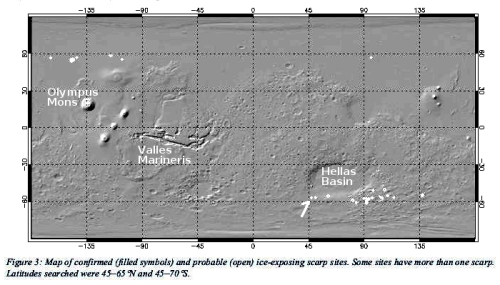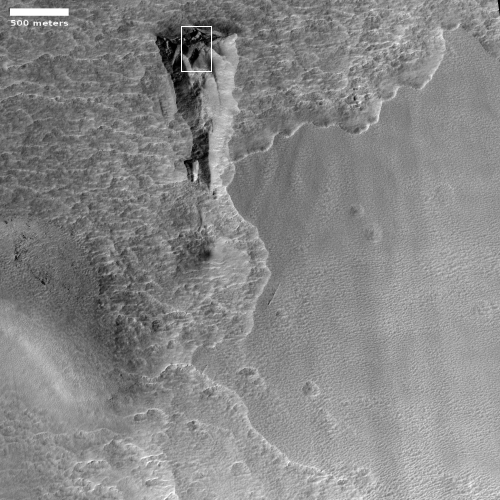Cliffs of Martian ice
Today’s cool image to the right, cropped to post here, shows an ice scarp located in the high southern latitudes south of Hellas Basin. It was taken on August 15, 2020 by the high resolution camera on Mars Reconnaissance Orbiter (MRO), and was released today as a captioned image. From the caption:
Scientists have come to realize that, just below the surface, about one third of Mars is covered in ice. We study this ice to learn about Mars’ ancient climate and astronauts’ future water supplies.
Sometimes we see the buried ice because cliffs form like the one in this image. On the brownish, dusty cliff wall, the faint light-blue-colored ice shows through. [emphasis mine]
This ice scarp is one of about two dozen [pdf] that have so far been found within the latitude bands of approximately 45 to 65 degrees latitude in both the north and south hemispheres. The data so far obtained suggests that the scarp exists because of a pure water ice layer just below the surface. Over time this pole-facing cliff retreats away from the pole towards the equator, leaving behind it an extended pit. In the cliff wall scientists think they have detected evidence of that water ice layer.
Blue in MRO hi-res images can indicate both water as well as very rough surfaces. While much of the blue here could be ether, the blocky cracks suggest it is ice. As explained by Colin Dundas of the U.S. Geological Survey’s Astrogeology Science Center in Arizona and lead author of the pdf above,
The crack patterns are likely thermal contraction cracks, which form in shallowly buried ice due to seasonal temperature changes causing it to expand and contract. When that repeats over many years it creates regular patterns of cracks that organize themselves into polygons.
The overview image below gives the location of all known such scarps, as of March of 2020, taken from the pdf paper that I linked to above.

The arrow points to the location of this particular scarp. From the pdf:
The limited latitude range of the scarps suggests that either the occurrence of the host icy units
or their ability to maintain exposures is controlled by temperature and insolation, and possibly related processes such as seasonal frost. Concentration at certain longitudes indicates that appropriate materials for forming the scarps are not ubiquitous and suggests that these areas are regions where snow was preferentially deposited and/or preserved. Scarps appear to correlate with rugged mesoscale topography such as massifs and craters, which may influence ice deposition and flow.
That the scarps are located in the same latitude bands where many glacial features are found suggests that it is not the presence of ice that causes them (that ice is definitely there), but the specific circumstances of the locale’s geology, interacting with the normal ebb and flow of the Martian yearly seasons as well as its very long term climate cycles.
The photo to the right, cropped and reduced to post here, shows the entire scarp, which is located on the floor of an unnamed 20-mile-wide crater. The white rectangle indicates the area covered by the color close-up above. The south rim of that crater is visible by the bright ridge in the image’s lower left. The large flat dissected area in the lower right suggests an ice field buried under a very thin layer of debris, and thus sublimating slowly, like ice will do if you spray it with hot water.
The most important tidbit however in this whole post is the highlighted text in the first quote above. At least one third of Mars is covered with ice. Mars is not the dry desert imagined by science fiction writers and astronomers after we got our first good views using telescopes beginning in the late 1800s. Instead, almost all of its surface in the mid- to high-laitudes is like Antarctica, an ice-covered desert where water might be plentiful, but frozen and requiring a lot of energy to make it drinkable.
On Christmas Eve 1968 three Americans became the first humans to visit another world. What they did to celebrate was unexpected and profound, and will be remembered throughout all human history. Genesis: the Story of Apollo 8, Robert Zimmerman's classic history of humanity's first journey to another world, tells that story, and it is now available as both an ebook and an audiobook, both with a foreword by Valerie Anders and a new introduction by Robert Zimmerman.
The print edition can be purchased at Amazon or from any other book seller. If you want an autographed copy the price is $60 for the hardback and $45 for the paperback, plus $8 shipping for each. Go here for purchasing details. The ebook is available everywhere for $5.99 (before discount) at amazon, or direct from my ebook publisher, ebookit. If you buy it from ebookit you don't support the big tech companies and the author gets a bigger cut much sooner.
The audiobook is also available at all these vendors, and is also free with a 30-day trial membership to Audible.
"Not simply about one mission, [Genesis] is also the history of America's quest for the moon... Zimmerman has done a masterful job of tying disparate events together into a solid account of one of America's greatest human triumphs."--San Antonio Express-News
Today’s cool image to the right, cropped to post here, shows an ice scarp located in the high southern latitudes south of Hellas Basin. It was taken on August 15, 2020 by the high resolution camera on Mars Reconnaissance Orbiter (MRO), and was released today as a captioned image. From the caption:
Scientists have come to realize that, just below the surface, about one third of Mars is covered in ice. We study this ice to learn about Mars’ ancient climate and astronauts’ future water supplies.
Sometimes we see the buried ice because cliffs form like the one in this image. On the brownish, dusty cliff wall, the faint light-blue-colored ice shows through. [emphasis mine]
This ice scarp is one of about two dozen [pdf] that have so far been found within the latitude bands of approximately 45 to 65 degrees latitude in both the north and south hemispheres. The data so far obtained suggests that the scarp exists because of a pure water ice layer just below the surface. Over time this pole-facing cliff retreats away from the pole towards the equator, leaving behind it an extended pit. In the cliff wall scientists think they have detected evidence of that water ice layer.
Blue in MRO hi-res images can indicate both water as well as very rough surfaces. While much of the blue here could be ether, the blocky cracks suggest it is ice. As explained by Colin Dundas of the U.S. Geological Survey’s Astrogeology Science Center in Arizona and lead author of the pdf above,
The crack patterns are likely thermal contraction cracks, which form in shallowly buried ice due to seasonal temperature changes causing it to expand and contract. When that repeats over many years it creates regular patterns of cracks that organize themselves into polygons.
The overview image below gives the location of all known such scarps, as of March of 2020, taken from the pdf paper that I linked to above.

The arrow points to the location of this particular scarp. From the pdf:
The limited latitude range of the scarps suggests that either the occurrence of the host icy units
or their ability to maintain exposures is controlled by temperature and insolation, and possibly related processes such as seasonal frost. Concentration at certain longitudes indicates that appropriate materials for forming the scarps are not ubiquitous and suggests that these areas are regions where snow was preferentially deposited and/or preserved. Scarps appear to correlate with rugged mesoscale topography such as massifs and craters, which may influence ice deposition and flow.
That the scarps are located in the same latitude bands where many glacial features are found suggests that it is not the presence of ice that causes them (that ice is definitely there), but the specific circumstances of the locale’s geology, interacting with the normal ebb and flow of the Martian yearly seasons as well as its very long term climate cycles.
The photo to the right, cropped and reduced to post here, shows the entire scarp, which is located on the floor of an unnamed 20-mile-wide crater. The white rectangle indicates the area covered by the color close-up above. The south rim of that crater is visible by the bright ridge in the image’s lower left. The large flat dissected area in the lower right suggests an ice field buried under a very thin layer of debris, and thus sublimating slowly, like ice will do if you spray it with hot water.
The most important tidbit however in this whole post is the highlighted text in the first quote above. At least one third of Mars is covered with ice. Mars is not the dry desert imagined by science fiction writers and astronomers after we got our first good views using telescopes beginning in the late 1800s. Instead, almost all of its surface in the mid- to high-laitudes is like Antarctica, an ice-covered desert where water might be plentiful, but frozen and requiring a lot of energy to make it drinkable.
On Christmas Eve 1968 three Americans became the first humans to visit another world. What they did to celebrate was unexpected and profound, and will be remembered throughout all human history. Genesis: the Story of Apollo 8, Robert Zimmerman's classic history of humanity's first journey to another world, tells that story, and it is now available as both an ebook and an audiobook, both with a foreword by Valerie Anders and a new introduction by Robert Zimmerman.
The print edition can be purchased at Amazon or from any other book seller. If you want an autographed copy the price is $60 for the hardback and $45 for the paperback, plus $8 shipping for each. Go here for purchasing details. The ebook is available everywhere for $5.99 (before discount) at amazon, or direct from my ebook publisher, ebookit. If you buy it from ebookit you don't support the big tech companies and the author gets a bigger cut much sooner.
The audiobook is also available at all these vendors, and is also free with a 30-day trial membership to Audible.
"Not simply about one mission, [Genesis] is also the history of America's quest for the moon... Zimmerman has done a masterful job of tying disparate events together into a solid account of one of America's greatest human triumphs."--San Antonio Express-News



